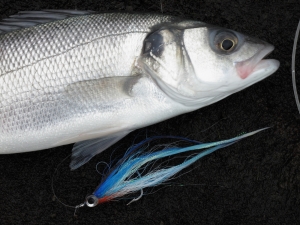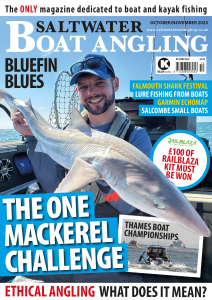While in lockdown Simon Everett has provided a great guide to making a special leader – for saltwater bass fishing.
 Those who have been readers for a while will know that I love my saltwater fly fishing. The simplicity and directness of contact elevates the activity to give heightened pleasure and, like a golfer with their swing, just the act of casting gives a sense of satisfaction all of its own, more than just whanging a lure out ever can, the pleasure aspect starts before the fly ever hits the water. Part of that casting process involves turning over the fly successfully at the end of the cast. To help with this various leaders have been developed over the couple of centuries that fly fishing has been popularised. For the trout fisher, who only has a short cast to make and a tiny, lightweight fly to turn over, albeit with the utmost delicacy of presentation, having sufficient energy isn’t a problem, but for the saltwater fly fisher, having to make long casts with a big fly that acts like a parachute, sapping energy the whole way, every bit of casting efficiency is a big help, that is where the furled leader comes in.
Those who have been readers for a while will know that I love my saltwater fly fishing. The simplicity and directness of contact elevates the activity to give heightened pleasure and, like a golfer with their swing, just the act of casting gives a sense of satisfaction all of its own, more than just whanging a lure out ever can, the pleasure aspect starts before the fly ever hits the water. Part of that casting process involves turning over the fly successfully at the end of the cast. To help with this various leaders have been developed over the couple of centuries that fly fishing has been popularised. For the trout fisher, who only has a short cast to make and a tiny, lightweight fly to turn over, albeit with the utmost delicacy of presentation, having sufficient energy isn’t a problem, but for the saltwater fly fisher, having to make long casts with a big fly that acts like a parachute, sapping energy the whole way, every bit of casting efficiency is a big help, that is where the furled leader comes in.
The history.
 The history of furled leaders goes right back to the beginnings of fly fishing, in order to present a fly as delicately as possible, with the minimum of splash so as not to spook a wary, wild fish, furled leaders were created from woven horse hair, gradually thinning towards the end, where a short length of catgut would be tied to the end for the final couple of feet. Those early horse hair leaders became replaced by silk, as the trading links with the Far East became established. Silk is a remarkable material, stronger than steel for its size, soft and supple so it knots well. Those early knots could now be refined to create slimmer profiles and reduce the splash even further, what’s more a silk leader could be treated with a wipe of mucilin grease to make it float, or left untreated to fish below the surface, searching out trout that were feeding on the bottom. Silk opened up a whole new range of tactics to the fly fisher.
The history of furled leaders goes right back to the beginnings of fly fishing, in order to present a fly as delicately as possible, with the minimum of splash so as not to spook a wary, wild fish, furled leaders were created from woven horse hair, gradually thinning towards the end, where a short length of catgut would be tied to the end for the final couple of feet. Those early horse hair leaders became replaced by silk, as the trading links with the Far East became established. Silk is a remarkable material, stronger than steel for its size, soft and supple so it knots well. Those early knots could now be refined to create slimmer profiles and reduce the splash even further, what’s more a silk leader could be treated with a wipe of mucilin grease to make it float, or left untreated to fish below the surface, searching out trout that were feeding on the bottom. Silk opened up a whole new range of tactics to the fly fisher.
Fast forward to the modern day, our technological lines are marvels of modern science, normal monofilament with its fine diameter, incredible knotting ability and elasticity to help absorb the shocks transmitted from a hooked fish. The new wonderline that is fluorocarbon, with its refractive index properties to make it all but invisible and with a specific gravity just greater than water so it sinks of its own accord, modern lines have revolutionised angling over the last 20 years or so, beyond anything our fathers could have dreamed of. That same requirement to turn the fly over at the end of the cast still remains though. Our rods are more refined than ever capable of casting an entire fly line, carrying a fly the size of a small herring, yet less than half the weight of a rod from even just 15 years ago, but the ability to transfer the energy to that last 3 or 4 yards of leader and tippet efficiently is still just as vital and nothing does it better than a furled leader.
Why a furled leader?
Tapered, knotless leaders retain memory and require stretching to remove their tendency to coil, regardless of what it says on the packet. A tapered leader works pretty well, but it still doesn’t turn a fly over as well as a furled leader, they don’t last as long, they are not as abrasion resistant, which is important if you are fishing over a reef, oyster or mussel beds and they don’t offer as much hook hold protection while you fight a hard fighting fish. The natural elasticity built in to a furled leader is a great help in protecting your contact with the fish during sudden lunges and head shaking situations.
Buy or make?
You can buy furled leaders, machine made in a workshop, from normal monofilament. You can still buy them made from silk in various bright colours to aid with visibility, but these options are both expensive, relatively, and buying a leader devolves the pleasure of fishing with something you have made yourself. I don’t know about you but I garner great satisfaction out of being able to do something myself and not have to rely on manufactured traces. A shop bought furled leader for a standard 8-weight line costs in the region of £8 – £10, for what amounts to a 10-yard length of fluorocarbon. Imagine if a 100-yard spool of 12lb fluorocarbon cost £800, would you still buy it? Yet that is what this price translates as! Why buy them when you can make your own, in your fingers, on the water if necessary, in a couple of minutes? Provided you take a little bit of care as you go, your hand rolled leader will be as good, or probably better, than one you can buy and you will have the added pleasure of having done it yourself.
Here’s how:
What material and what strength line you use will depend on the line weight and type of fishing you are going to do, so I carry a couple of different spare leaders with me. On a floating line for using surface flies, such as the Crease fly or Gurgler and other surface disturbance patterns that require the line to stay near the surface of the water, I use standard monofilament, such as Shimano Aspire or Berkley Trilene XL, nothing fancy just ordinary lines. For sinking lines I use fluorocarbon, for its extra density to help maintain a direct contact with the fly. I like to carry a readymade spare for each line, so I don’t actually have to make them on the boat or kayak, but if you need to, you can. It is much easier to make them while stood up.
The weight of the fly line you are using will dictate the breaking strain of the monofilament you use. For most people fishing in the UK, and even overseas fishing for bonefish and small tarpon, the 8-weight is the standard size outfit, for this I use 12lb Berkley Trilene XL, or if there is a chance of a really big fish I will go up to 15lb, which gives a leader of nearly double the breaking strain of the line you are using. For the fluorocarbon leaders I just use 15lb, because you are fishing closer to snags the extra abrasion and breaking strain comes in useful and being below the surface the extra diameter is less noticeable. To the end of the furled leader attach a normal piece of single strand tippet, 4 to 5 feet is plenty usually but for very wary fish you can add 8 or 9 feet happily and still get good turnover when fishing in the shallows.



